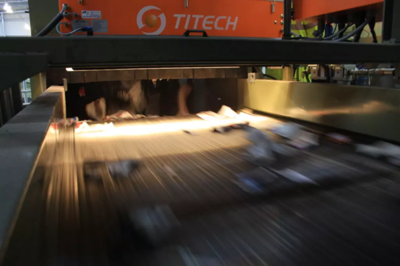NIR Optical Sorting: Difference between revisions
Created page with "Category:Technologies & Solutions Near infra-red/NIR Optical Sorting systems use advanced infra-red sensors to effectively identify materials of different wavelengths...." |
add pic |
||
| (12 intermediate revisions by 3 users not shown) | |||
| Line 1: | Line 1: | ||
Near infra-red/[[NIR Optical Sorting]] systems use advanced [[Wikipedia:Infrared|infra-red]] sensors to effectively identify materials/[[Feedstock|feedstock]] of different wavelengths. The targeted materials are then ejected via a compressed air valve to achieve the purpose of sorting<ref>[https://www.hbsorter.com/solution/Nir-Optical-Sorter.html NIR Optical Sorter]</ref>. | |||
[[Category:Technologies & Solutions]] | [[Category:Technologies & Solutions]] | ||
[[File:Picture11234.png|400px|left|Titech NIR sorting, all rights reserved]]__TOC__ | |||
<br clear='left'/> | |||
==History== | |||
The first NIR sorting systems were used to process [[Recyclables|recyclable]] materials at the beginning of the 1990s and the technology has developed significantly in the past five to 10 years. These systems are frequently used in [[MRF]]s to streamline the sorting process, reduce labour costs, and increase the throughput to make [[Recycling|recycling]] operations more efficient<ref name="ref1">[https://crigler.com/how-optical-sorting-systems-work-for-recycling/ How Optical Sorting Systems Work for Recycling]</ref>. [[NIR Optical Sorting]] systems are capable of processing [[Packaging Waste|packaging]], [[Paper|papers]], [[Waste|waste]] [[WEEE|electrical equipment]], [[Residual Waste|residual waste]] ([[RDF]]), [[Plastic|plastics]] and vehicle [[Recycling|recycling]]<ref name="ref2">[http://www.wasteminz.org.nz/wp-content/uploads/Ernie-Beker.pdf Automatic Sorting of Recyclable Materials With NIR Technology]</ref>. | |||
==The Principle== | |||
The basic principle behind the NIR technology is measuring the wavelength of the light that bounces off an object. The conveyor in a [[MRF]] moves the material under a bright light which fires near infra-red wavelengths of light at the [[Recyclables|recyclables]]. Some of the wavelengths are absorbed while others are reflected by the material. The NIR sensors that are positioned in the last third of the conveyor record the characteristics of the wavelengths bounced back from the material. From there they are able to determine and target the different types of [[Recyclables|recyclables]] on the belt<ref name="ref2" /> and eject the selected material from the end of the conveyor via a jet of compressed air. | |||
==The Process== | |||
{| | |||
|- | |||
| | |||
#The [[Waste|waste]] material is loaded onto an accelerator/fast speed conveyor to thin the [[Recyclables|recyclables]] out | |||
#The conveyor moves the material under a bright light which fires infra-red wavelengths of light towards it | |||
#A series of NIR sensors that are pointed at the conveyor record the distinct light signature/fingerprint that bounces back from the [[Recyclables|recyclables]] to identify what each piece of material is | |||
#A computer calculates the desired [[Recyclables|recyclable’s]] location and sends a blast of compressed air at the correct timing via a nozzle located at the end of the conveyor, normally under the material | |||
#The specific [[Recyclables|recyclable]] material is detected and ejected by the compressed air - it is blown over a 'material splitter' to separate it from the remaining flow of [[Waste|waste]] | |||
#Most of the sorting systems include a quality control step at the end to ensure the purity of the material being sorted<ref name="ref1" /> | |||
#Materials may be sorted via a series of NIR units, each focused on a different material | |||
|| | |||
[[File:NIR Optical Sorter Diagram.png|500px|right|NIR Optical Sorter Diagram. All rights reserved.]]<br clear=all>''NIR Optical Sorter''<ref>[http://eaglevizion.com/optical_sorting NIR Optical Sorter Diagram]</ref> | |||
|} | |||
==Near Infra-Red/[[NIR Optical Sorting]] in the Plastics Recycling Process== | |||
NIR sorting is widely used to separate [[Plastic|plastic]] by NIR Optical Sorting via transmission or reflection, sometimes in a dedicated [[Plastics Recovery Facility]]. Automatic sorters interface NIR sensing with air nozzles to sort [[Plastic|plastic]] items of various resin compounds/[[Plastic|plastic]] polymer types. The sensors are positioned above the high-speed conveyor and detect the unique wavelength signature of the desired polymers which subsequently get directed by air jets to their specific [[Waste|waste]] streams. Contaminants become the [[Waste|waste]] output or are directed for further processing<ref>[https://plasticsrecycling.org/images/Design-Guidance-Tests/APR-RES-SORT-2-NIR-sorting-resource.pdf Near Infra-Red (NIR) Sorting in the Plastics Recycling Process]</ref>. | |||
==References== | ==References== | ||
<references /> | <references /> | ||
Latest revision as of 15:24, 26 October 2021
Near infra-red/NIR Optical Sorting systems use advanced infra-red sensors to effectively identify materials/feedstock of different wavelengths. The targeted materials are then ejected via a compressed air valve to achieve the purpose of sorting[1].

History
The first NIR sorting systems were used to process recyclable materials at the beginning of the 1990s and the technology has developed significantly in the past five to 10 years. These systems are frequently used in MRFs to streamline the sorting process, reduce labour costs, and increase the throughput to make recycling operations more efficient[2]. NIR Optical Sorting systems are capable of processing packaging, papers, waste electrical equipment, residual waste (RDF), plastics and vehicle recycling[3].
The Principle
The basic principle behind the NIR technology is measuring the wavelength of the light that bounces off an object. The conveyor in a MRF moves the material under a bright light which fires near infra-red wavelengths of light at the recyclables. Some of the wavelengths are absorbed while others are reflected by the material. The NIR sensors that are positioned in the last third of the conveyor record the characteristics of the wavelengths bounced back from the material. From there they are able to determine and target the different types of recyclables on the belt[3] and eject the selected material from the end of the conveyor via a jet of compressed air.
The Process
|
 NIR Optical Sorter[4] |
Near Infra-Red/NIR Optical Sorting in the Plastics Recycling Process
NIR sorting is widely used to separate plastic by NIR Optical Sorting via transmission or reflection, sometimes in a dedicated Plastics Recovery Facility. Automatic sorters interface NIR sensing with air nozzles to sort plastic items of various resin compounds/plastic polymer types. The sensors are positioned above the high-speed conveyor and detect the unique wavelength signature of the desired polymers which subsequently get directed by air jets to their specific waste streams. Contaminants become the waste output or are directed for further processing[5].
